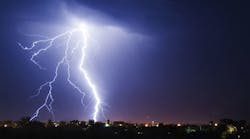When a diverse group of lightning protection experts, engineers, and safety directors met at the 82nd annual LPI/ULPA Lightning Protection Conference in Singer Island, Fla., last February to discuss industry issues, “quality control” was a central theme that dominated many presentations and discussions. Several months later, a smaller group of lightning protection experts met in Kansas City for the Lightning Protection Institute (LPI) board meeting to review a range of industry issues. Once again, the importance of quality control was highlighted as an industry priority for 2015 and beyond.
“The need for quality control is not a new concept, but concerns about quality control are on the rise,” said Bud VanSickle, executive director for LPI. “A trend is developing with outside trades like electrical and roofing contractors attempting to grow their business by dabbling in lightning protection installation. This is a problem, as lightning protection specifications call for installation in accordance with national safety standards (NFPA 780 and UL 96/96A), UL-listed materials, and work performed by LPI-certified lightning protection specialists.”
The International Association of Electrical Inspectors (IAEI) reiterates the importance of LPI-certified and UL-listed installers for lightning protection applications. IAEI devoted a new chapter to its 10th edition of the Soares Book on Grounding and Bonding in 2008 called, “The Fundamentals of Lightning Protection.” This chapter was further updated and expanded in the 11th edition, which was released in 2011. The handbook now includes a reminder to electrical contractors that “installation of a lightning protection system is much different from the installation of electrical service wiring.”
According to the Soares handbook, “specialized material and installation methods such as that specified in NFPA 780 and UL 96 are required, and the system should only be installed by qualified personnel trained and certified in the installation of lightning protection systems.”
“Intertek is in favor of the lightning protection industry’s position to promote installation by specialized and qualified contractors,” said Gary Flom, service line leader, U.S. Field Services at Intertek in Atlanta. “Many state regulations are not stringent where lightning protection installers are concerned, which is why LPI’s emphasis on third-party inspection for quality control is healthy for the industry and beneficial for the consumer.”
Intertek provides third-party lightning protection inspection services for the LPI Inspection Program (LPI-IP), which facilitates on-site inspection services, follow-up inspection reports, and the issuance of certification for lightning protection systems that comply with LPI, NFPA, and UL Standards. According to Flom, Intertek’s inspection and field services program is built around the requirements of OSHA standards. LPI-IP inspections are accepted in MasterSpec as a quality control inspection option for lightning protection.
As in most service industries, issues regarding counterfeit and fraudulent third-party inspections can be of special concern for lightning protection quality assurance. UL senior project engineer Eric Boettcher shared information with the February LPI/ULPA conference attendees about UL’s “Market Surveillance Group,” which investigates fraudulent violations pertaining to third-party inspections of lightning protection systems. According to Boettcher, UL has an “aggressive stance against counterfeiting” to promote quality control in the marketplace.
“Counterfeiting hasn’t been an issue with our lightning protection inspection program, but it is always a concern for Intertek,” said Flom. “We invest in the education of authorities having jurisdiction, and our inspectors are qualified and equipped to understand lightning protection requirements in the field. Intertek’s speed to schedule inspections and consumer-driven service are important aspects of our quality assurance program.”
Just as inspections are a standard practice in the world of construction, it’s understood that lightning protection systems must be inspected following completion of their installation (see Demystifying the Inspection Process). Independent review provides the purest evidence that the installing contractor has met all industry guidelines and complied with recommended practices and safety standards.
The LPI-IP Inspection Program provides system certifications with a three-year expiration date to complement the NFPA three-year code review process and keep pace with new technology.
Editor’s note: LPI is a nationwide not-for-profit organization founded in 1955 to promote lightning protection education, awareness, and safety. Visit www.lightning.org. Information about follow-up, third-party inspection services can be found at www.lpi-ip.com.
Loehr is communications director for the Lightning Protection Institute (LPI) in Maryville, Mo. She can be reached at [email protected].
Sidebar: Demystifying the Inspection Process
Since lightning protection is a specialized industry, it can be difficult for those not familiar with these systems to know what to expect when it comes to third-party inspection. Here are a few guidelines to help you better understand the inspection process.
Why do I need the lightning protection system inspected?
The lightning protection system is an important amenity that provides protection against a leading cause of property damage. An independent inspection provides peace of mind to the owner and ensures materials and methods comply with recommended practices and industry safety standards.
Do I need to be on-site or present for the inspection?
If possible, it’s always a good idea for the installing contractor or project manager (PM) to be on-site during a lightning protection inspection. This gives you an opportunity to make minor repairs or upgrades to the system as needed.
What if the inspection report reveals problems or issues with the system?
Depending upon the project, the inspector will issue a certification or report several days/weeks after the inspection. Most lightning protection contractors address installation repairs or issues during the inspection. If this is not feasible, the inspector will forward a variance or noncompliance letter to the contractor. This variance report summarizes issues and corrective measures needed for system compliance. A follow-up inspection or appropriate documentation of corrective measures is typically required to verify compliance so that inspection certification can be issued.
How much do inspections cost?
Lightning protection inspection services typically base their costs on the perimeter size of the structure. Geographic factors may need to be considered, and minimal fees for additional services such as ground tests or follow-up reports may apply as well. It’s always a good idea to ask about inspection costs up-front. While a third-party inspection may add an additional cost to the contract, it shouldn’t be a deciding factor with the owner/customer.




